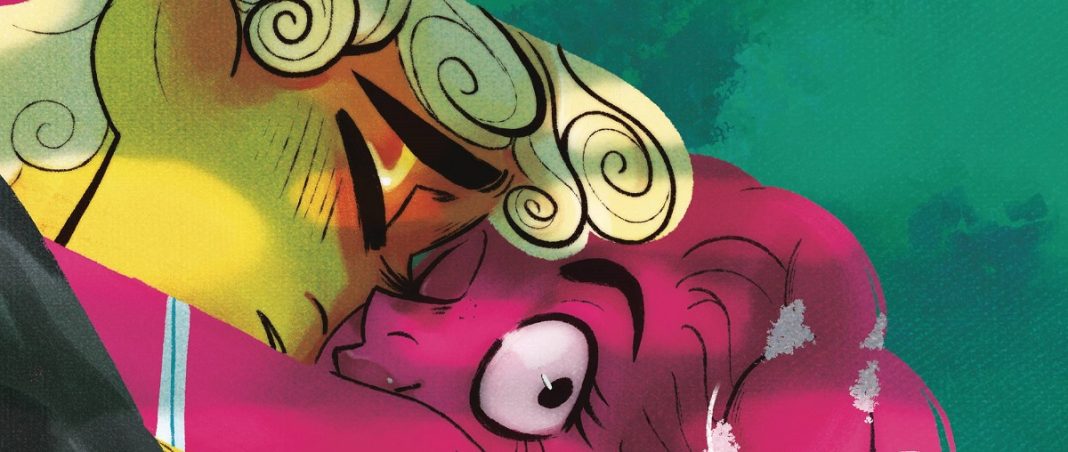 Lore Olympus Vol. 4
Lore Olympus Vol. 4
Creator: Rachel Smythe
Layouts: Edwin Vazquez
Publisher: Del Rey
The retelling of myth reflects the past onto the present day (with thanks to my old professor Rachel Hadas for introducing me to this idea). It takes a story that many are familiar with, playing with that narrative we know while engaging us in the new version. A huge part of the joy of retellings is in the retelling itself. What’s changed? What’s stayed the same? Why has the author chosen to revisit this story now?
All of this is at the heart of Rachel Smythe’s Lore Olympus. This is the series that someone in your life has been following for years now or has become their most recent obsession as it’s been viewed 1.3 billion times and has 6.4 million subscribers (via Webtoons) as of September 2023. The absolute smash hit has garnered Eisners in 2022 and 2023 and three Harvey awards, while making the transition from digital to physical with reprints in four volumes, with Volume 5 releasing in October 2023.
For the uninitiated, Lore Olympus follows Hades and Persephone, along with a slew of other gods, nymphs, and humans, as they become Hades AND Persephone. It’s a retelling of The Taking of Persephone, which is most often remembered as the mythological explanation of where the seasons come from. While Persephone is with her mother in the mortal realm, we get spring and summer, but while Persephone lives with Hades in the underworld, our world is plunged into fall and winter. Smythe’s retelling digs further into the love story of Hades and Persephone (which in most versions is a kidnapping more than courtship), setting it in a contemporary Olympus and Underworld with cars, mega corporations, ads for diet pomegranate juice, and university scholarships.
The fourth volume of Lore Olympus includes episodes 76 to 102 (compared to the Webtoons page which is currently at episode 250), covering a growing connection between Hades and Persephone, with a much clearer focus on Persephone’s backstory. We also are introduced to Ares as a more central character, deal a bit with Apollo’s abuse, and end with Hades and his current significant other, Minthe, coming closer to a possible end. From the summary alone, it’s clear that this titan of a webcomic has a lot of moving parts that keeps sucking you deeper into this world.
Volume 4 continues Rachel Smythe’s (along with her talented assistants Jaki Haboon, Kristian Ness, Hita, and Joey Ahumada, among others) extraordinary use of color which has helped catapult this comic to extreme success. Though it has been written about in many other spaces, the ways in which color is used as symbol and signifier throughout all of Lore Olympus remains its greatest strength by far. Each pink and blue and yellow and purple explodes in your vision making reading this comic some of the most delicious meals you’ll have all week. Add to this the ways that Smythe and her team use lines to hold together those colors (or not!) in strikingly complex ways, one cannot overstate this artistic splendor.
Though the color and lines propel the eye forward, one of the unique strengths of Volume 4 is its growth into the physical edition. Online, the spacing between panels become these massive gutter spaces where time, space, and dramatic effect all weave together to slow down the reading. On the page, the spaces between panels are not as distinct. Smythe and company, adding Edwin Vasquez on layouts, adhere more distinctly to a traditional printed page. Some devoted fans of the Webtoon version will find themselves standoffish at this change in panel layout, especially if they have not read any of the physical versions so far. But, Smythe and Vasquez adapt to the page in nuanced ways. While many webcomics that jump to physical format seek to keep their original layout/feel of the paneling, many times that doesn’t translate well to the page. Understanding that the physical medium of delivery is different than digital is a massive strength of all this volume. The understanding of space, timing, and gutters have delivered a completely unique reading experience from the digital version. The differences are stark, but it provides a space for making the webcomic feel new again.
The story itself is a slow burn romance which will not be everyone’s cup of tea. As of this volume, Hades and Persephone have held hands, hugged, and talked. For more than a thousand physical pages, this speed can make you forget to breath. Add on the extremely sexy character portrayals, reflective at times of old pin-ups, there will be times you’ll have to put down the book just to survive the next few pages. For those willing to let it move like a snail through a tar pit, there’s great reward in the narrative tension. This slow burn also layers in with the retelling itself.
Often, as the front matter warns, the comic dips into what unhealthy and abusive relationships look like. These are always set up against the Hades/Persephone love story so that we see Smythe’s conversation about love, relationships, and consent more clearly. The most troubling issue with the original myth is the sexual violence inherent in Hades’ kidnapping of Persephone. In a contemporary retelling, the need for a reimagining or coming to terms with this seems necessary. Smythe’s retelling does just this by taking care to present consent, choice, conversation, and mutual decision making as central tenants of a healthy relationship. Even though we know Hades and Persephone end up together and their mutual attraction to each other is immediate, Lore Olympus stays dedicated to presenting a healthy dynamic based in open communication. Therefore, until Hades and Persephone can be fully honest with each other, they don’t end up together.
This value on love as consent takes center stage more than the relationships that result in pain and cruelty. The focus on the positive is in line with the comic’s goal, which leaves many of the male perpetrators of violence with long stretches of episodes before they’re called out. The massive number of moving characters and the need to build suspense through a long, ongoing story results in this faucet drip of resolution throughout. It’s satisfying, in this volume, to see Apollo get reamed by Persephone, but it isn’t a resolution either, which keeps the suspense alive while also pulling the reader to stick around for the final, inevitable blowout.
Lore Olympus Vol. 4 is an absolute stunner of a serial comic. Rachel Smythe’s massive undertaking to retell this myth, piece by tiny piece, recreating the original as a skyscraper sized puzzle or tapestry, is awe inspiring. The way she and her team, both digitally and in print, care for this story makes it a mistake to ignore. The ubiquitous presence of this comic, especially online, will surely ripple through webcomics and graphic narratives to come. Lore Olympus is stretching what has only seemed possible in properties backed by major publishers or syndicates to include long form digital storytelling. With this print release and the next volume coming so soon, Smythe’s massive audience has grown by, at least, one.
Verdict: Buy (for fans) Borrow from Library (new readers)
Read a new entry in the Trade Rating series every Thursday at The Beat.
Lore Olympus Vol. 4 is available now.










